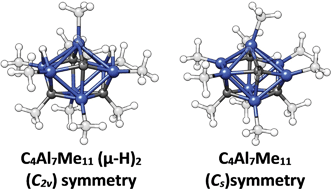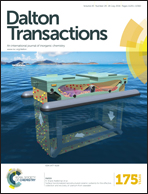Tetracarbalane structures: nido polyhedra and non-spherical deltahedra†
Abstract
Uhl and coworkers have synthesized and characterized structurally the 11-vertex tetracarbalanes (AlMe)7(CEt)4(μ-H)2 and (AlEt)7(CCH2Ph)4(C![[triple bond, length as m-dash]](https://www.rsc.org/images/entities/char_e002.gif) CPh)(μ–H). In order to understand the nature of the unusual C4Al7 polyhedra in such systems, the complete series of permethylated tetracarbalanes C4Aln−4Men (n = 6 to 14) as model compounds have been investigated using density functional theory. An overriding factor in determining the polyhedra for the lowest energy structures of a wide range of tetracarbalanes C4Aln−4Men (n = 6 to 14) is the availability of vertices of degrees 3 and 4 for all four carbon atoms. For the 11-vertex C4Al7Me11 system the experimentally observed C4Al7 deltahedron with carbon atoms at the four degree 4 vertices is found in the lowest energy structure but severely distorted from ideal C2h to Cs symmetry. This distortion is removed by adding two bridging hydrogens to the C4Al7Me11 structure in the same locations as in the experimental structures. The lowest energy structures of the tetracarbalanes C4Aln−4Men (n = 12, 13, 14) with more than 11 vertices are deltahedra having the carbon atoms at degree 4 vertices similar to the lowest energy C4Al7Me11 structures. The lowest energy structures for the smaller tetracarbalanes C4Aln−4Men (n = 6, 7, 8) are nido structures with pentagonal or hexagonal open faces related to nido borane structures. The intermediate 9- and 10-vertex tetracarbalanes C4Aln−4Men (n = 9, 10) have relatively complicated energy surfaces.
CPh)(μ–H). In order to understand the nature of the unusual C4Al7 polyhedra in such systems, the complete series of permethylated tetracarbalanes C4Aln−4Men (n = 6 to 14) as model compounds have been investigated using density functional theory. An overriding factor in determining the polyhedra for the lowest energy structures of a wide range of tetracarbalanes C4Aln−4Men (n = 6 to 14) is the availability of vertices of degrees 3 and 4 for all four carbon atoms. For the 11-vertex C4Al7Me11 system the experimentally observed C4Al7 deltahedron with carbon atoms at the four degree 4 vertices is found in the lowest energy structure but severely distorted from ideal C2h to Cs symmetry. This distortion is removed by adding two bridging hydrogens to the C4Al7Me11 structure in the same locations as in the experimental structures. The lowest energy structures of the tetracarbalanes C4Aln−4Men (n = 12, 13, 14) with more than 11 vertices are deltahedra having the carbon atoms at degree 4 vertices similar to the lowest energy C4Al7Me11 structures. The lowest energy structures for the smaller tetracarbalanes C4Aln−4Men (n = 6, 7, 8) are nido structures with pentagonal or hexagonal open faces related to nido borane structures. The intermediate 9- and 10-vertex tetracarbalanes C4Aln−4Men (n = 9, 10) have relatively complicated energy surfaces.


 Please wait while we load your content...
Please wait while we load your content...